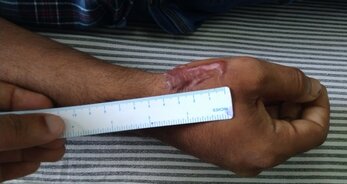|
Breast augmentation is an important part of sex reassignment surgery (SRS) in transwomen. It helps avoid the use of external padding to achieve a feminine appearance. It enables an individual to integrate better with the body image.
There are both similarities and differences in breast augmentation in SRS when compared to augmentation carried out in women to enhance the appearance of breasts. Breast augmentation is usually achieved with the help of silicone implants. The technique is largely similar to breast augmentations carried out in women for hypomastia. However, there are certain differences relating to the preoperative requirements, and outcomes. As in other procedures carried out in SRS, breast augmentation requires the clearance and referral letter from a mental health professional. Most individuals are also on hormonal therapy under the guidance of a physician. Hormonal treatment helps in breast development and the enlargement of the nipple and areola. Improvement in the size of breasts with hormonal treatment leads to better soft tissue coverage over the implants. This helps in optimizing outcomes. Breast augmentation is usually carried out after two years of hormonal treatment. The contour of a male chest is different when compared to a female chest. The male chest tends to be wider and more muscular. Also, the soft tissue cover including skin tends to be less yielding in a natal male when compared to a natal female. The crease that separates the breast from the lower part of chest is known as the inframammary fold (IMF). The distance between the nipple to IMF is lesser in men when compared to women. Breast augmentation leads to an increase in this distance. The nipple and areola (pigmented skin surrounding the nipple) are more laterally (towards the sides) placed in men when compared to women. In women, the nipple-areola is more centrally located in the chest. These variations in the anatomy also influence our decision making relating to the implant selection and outcomes. Ideally, the nipple and areola should be on the apex of the breast mound. The lateral position of the nipple relative to the chest in a natal male can lead to a lateral position of the nipple after the placement of a large diameter implant. This is factored into the decision making during implant selection. Traditional silicone implants are hemispherical. Profile or projection refers to the height when the implant is kept on a flat surface. A high profile implant also has the advantage of helping us to achieve the maximum projection for a given breast volume. It is common to opt for a relatively lesser diameter and high profile (projection) implants. The placement of the implant can be under the breast tissue (sub-glandular) or partly under the muscle (sub-pectoral). Both approaches have their relative advantages and disadvantages. The decision is taken after taking into account clinical examination findings and discussion with the individual. Breast augmentation is carried out as a short stay procedure. The recovery is similar to breast augmentation carried out in females for hypomastia. Most individuals return to work within a week of undergoing the procedure. The implant is initially found to have a prominent upper pole fullness. This settles into a more natural-looking appearance over the next few months. Breast augmentation is a relatively simple procedure with significant benefits in suitable individuals. It is an important part of the gender confirmation procedures. It is associated with positive effects on body image, self-confidence. For more information about breast augmentation. A + B = C. So C - B = A. This may apply to simple arithmetic, but things get a bit complex when we are dealing with weight gain and weight loss.
We store our excess energy in the form of fat. Excess calories we may have acquired from our diet. This excess of fat gets stored in our body as fat deposits in different locations. Fat immediately under the skin can be pinched. This layer of fat is found between the skin and muscles. This is also the layer that can be removed with liposuction. Fat also gets stored deep inside our body, close to our internal organs. This is visceral fat. We can neither pinch this fat nor get it removed with plastic surgery. A proper diet can help us get back to our ideal body weight. In some situations, bariatric surgery achieves the same end. However, a prolonged period of increased fat has effects beyond the fatty tissue. It stretches out the overlying skin. Visceral fat also stretches out the fascial layer. This layer is closely associated with the abdominal muscle layer. When we lose fat, the size of the fatty layer reduces. This may be dramatic in cases of severe weight reduction as with weight loss (bariatric) surgery. The stretched out skin and fascia may not get back to the dimensions before the weight gain. As a result, individuals end up with loose folds of skin. To improve this appearance, we have to surgically remove the excess folds of skin. These surgeries are together clubbed under body contouring procedures. We usually wait for a year or more for the weight to stabilize and allowing the skin to recoil by itself before attempting any skin correction. The same approach is used for different body parts, arms (brachioplasty), abdomen (abdominoplasty), thighs (thighplasty) and torso (body-lift). The presence of stretched out skin and fascia is the reason why liposuction may not be the right procedure for abdominal fat. Liposuction can't do much to tackle the laxity of skin and underlying abdominal fascia. With liposuction alone, we may worsen the skin laxity of the abdomen resulting in an increase in loose folds of skin after the procedure. The same line of reasoning is applied to individuals who present for a reduction in the size of arms. We undertake it in two stages, with the first being deflation with diet or liposuction and a second stage with the removal of loose folds of skin. To conclude, we have to tackle the laxity of skin and deeper fascia in cases of weight loss following periods of excess weight gain. These may have undergone irreversible changes. Treatment of such deformities often requires the management of tissues like skin and fascia with the help of body contouring procedures. Such an approach helps us to optimize aesthetic outcomes. Visit the following to learn more, 1. Liposuction 2. Brachioplasty 3. Abdominoplasty Male pattern baldness (MPB) is a progressive condition. The extent of baldness in MPB is described using Norwood classification wherein I is the mildest and VII is the most severe. Male pattern baldness (MPB) begins with the recession of the hairline in front and progresses to involve the hair on the top of the head (mid-scalp) and the back of the head. It is difficult to predict the extent (severity) to which a person with MPB will lose hair and the speed or rate at which the hair would be lost.
We adopt two strategies for the management of MPB. They include those for the prevention of hair loss and those for redistribution of the hair follicles. The former involves medications and the latter is achieved with hair transplantation (surgery). With the progress of MPB, there are certain changes observed in the appearance of the hair shafts. They become smaller in length and diameter. Hair shafts in the scalp occur in bunches of single, two, three or four shafts. These are referred to as follicular units (FU). In MPB, the average number of shafts in an FU reduce with a predominance of singles and doubles. The number of hair follicular units in a given area (hair shafts per square cm) reduces with the progression of baldness. All of the above changes contribute to the seemingly less dense look with increased visibility of the scalp. With preventive strategies, we are trying to halt these changes found in the scalp. Prevention is important because this alone tries to preserve the total number of follicular units. Hair transplantation (HT) on the other hand is essentially a redistribution of FU. Hair transplantation does not do anything for preventing the progress of MPB. Both these modalities are adopted together in the management of MPB. The relative importance of prevention versus surgery in a given individual depends on the clinical presentation. In cases of early MPB with ongoing loss, prevention is more important when compared to individuals presenting with a stable pattern of MPB (without significant ongoing loss). In other words, the treatment plan is customized based on the findings seen in an individual. Prevention is undertaken using medications. These include oral and topical (local application) medicines. Oral medications include, nutritional therapy wherein nutritional supplements are given regularly to take care of the nutritional deficiencies associated with hair loss. The supplements include vitamins, minerals, amino acids, and essential fatty acids. Another oral medication for MPB is Finasteride. Finasteride blocks the conversion of testosterone to dihydrotestosterone (DHT). In MPB, the hair follicles in the loss prone area of the scalp have an abnormal sensitivity to DHT. The effect of DHT mediates the changes observed in MPB. Finasteride thus helps reduce the effect of DHT on the hair follicular cells. Finasteride is uncommonly associated with loss of libido and associated symptoms. Studies have reported an incidence of these effects of one in fifty individuals. Despite this Finasteride is an important medication for the management of MPB. Topical Minoxidil is another useful drug in MPB. Minoxidil was first introduced as an oral medicine for the treatment of hypertension. It was soon found to have positive effects on the growth of hair. Minoxidil comes in various strengths. Minoxidil is usually applied twice daily on the scalp. Minoxidil should be allowed to have a scalp contact time of more than an hour before it is washed away. Individuals are asked to apply minoxidil after drying hair following a shower. Minoxidil is useful in the mid-scalp region. Continuous use over a few months is needed before optimal results are seen. Preventive strategies are important in the management of MPB. They help preserve the existing hair follicles. The use of the medications also needs a high level of motivation and they give the best results with continued use. Both preventive medicines and surgery play an important role in achieving a good outcome in MPB. Both of these strategies are complementary. One can't substitute the other. In other words, a good transplant can't reduce the importance of steps for the prevention of hair loss. Earlobe repair is a commonly requested procedure in our practice. A wide aperture results in an ungainly appearance with dangling of disc-shaped earrings. There is also a risk of complete disruption of the bridge of tissue and a split earlobe.
Earlobe repair is done under local anesthesia as an outpatient procedure. We usually perform our repair using a technique that helps us to avoid a further session of ear piercing. The existing hole is modified such that it becomes smaller and retains its original position. This avoids the risk of having an eccentric position of the aperture during a secondary piercing. Individuals who come for earlobe repair should have an understanding of the reasons for the deformity. Heavy earrings and multiple trivial trauma lead to a lengthened aperture. It is prudent to avoid heavy earrings after a repair. The repair has an approximate strength of ten percent of the intact neighboring skin. This increases to fifty at three months and seventy at one year. This is independent of the technique and is related to our wound healing and scar strength. And because of this, we advise our patients to avoid heavy earrings for one year following a repair. This helps contribute to the longevity of a good result. Scars are an inevitable consequence of injuries. The deeper and more severe the injury, the greater the resultant scar. However, in certain situations, a scar can be unduly prominent. The scar tissue may raise above the surrounding skin. It may also be associated with symptoms such as itching and deformity. Such a presentation is usually suggestive of a hypertrophic scar. What causes hypertrophic scarring? Prolonged healing times can contribute to a hypertrophic scar. In other words, wounds that take a long time to heal are more likely to end up as hypertrophic scars. In some individuals, there is an inherent tendency to have hypertrophic scars. Sometimes milder injuries can end up as very prominent scars in such individuals. Unfortunately, we can't get rid of this tendency of such patients to have prominent scars. What are the treatments available for hypertrophic scars? Certain treatment modalities help prevent and achieve early resolution of hypertrophic scarring. Prevention is recommended in individuals who are prone to such scars. If an individual is prone to such scarring it would be wise to deliberate before going for procedures such as tattoos or piercings. It is also better to bring this to the attention of a surgeon before elective surgery. The modalities used for prevention and treatment are similar. These include the application of silicone sheet, pressure garments and intralesional injection of immunomodulatory substances. These are usually carried out for prolonged periods for sustained benefits. Surgery has a limited role in the treatment of hypertrophic scars. Can hypertrophic scars be prevented? Some measures can reduce the likelihood of such an outcome. They include steps to hasten wound healing. Wounds that take more than two weeks to heal have a higher likelihood of ending up as hypertrophic scars. In individuals who have a history of prominent scars use of silicone sheets and pressure, garments are recommended. In certain situations, we also recommend the use of intralesional agents. What is the role of surgery in the treatment of hypertrophic scars? After treatment, the hypertrophic scars usually flatten out and become atrophic. Atrophic scars appear as thinned out and shiny. Surgery is a good option for the management of atrophic scars. The surgical procedures for atrophic scars include scar revision and fat grafting. To learn more about scars and various treatments please click here. |
AuthorI like to keep it simple. CategoriesArchives
June 2024
Categories |
- Home
-
Cosmetic
- Fat grafting
- Swellings and moles
- Scar revision
- Leukoderma (Melanocyte transfer)
- Hair transplant
- Facial rejuvenation procedures
- Nose job (Rhinoplasty)
- Cleft lip nose correction
- Ear (Otoplasty)
- Lip reduction
- Breast augmentation
- Breast reduction
- Tuberous breasts
- Axillary breasts
- Gynecomastia
- Liposuction
- Brachioplasty (Arm contouring)
- Abdominoplasty (Tummy tuck)
- Female genital rejuvenation
-
Reconstructive
- Contact
- Blog
- Home
-
Cosmetic
- Fat grafting
- Swellings and moles
- Scar revision
- Leukoderma (Melanocyte transfer)
- Hair transplant
- Facial rejuvenation procedures
- Nose job (Rhinoplasty)
- Cleft lip nose correction
- Ear (Otoplasty)
- Lip reduction
- Breast augmentation
- Breast reduction
- Tuberous breasts
- Axillary breasts
- Gynecomastia
- Liposuction
- Brachioplasty (Arm contouring)
- Abdominoplasty (Tummy tuck)
- Female genital rejuvenation
-
Reconstructive
- Contact
- Blog
You can leave us a comment using the contact form below.
We shall get back to you at the earliest.
We shall get back to you at the earliest.
Links
- Face procedures | Rhinoplasty, Otoplasty, Lip reduction, Fat grafting
- Body procedures | Gynecomastia , Breast reduction, Abdominoplasty, Brachioplasty, Liposuction
- Skin procedures | Scar revision, Moles, Leukoderma surgery
Let's be friends !
Follow us at Facebook and Twitter.
Follow us at Facebook and Twitter.
© 2024 Amicus Clinic (Plastic Surgery Centre, Trivandrum). All rights reserved.

 RSS Feed
RSS Feed



